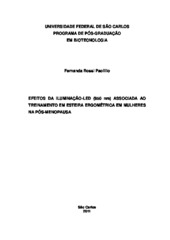Efeitos da iluminação-LED (850 nm) associada ao treinamento em esteira ergométrica em mulheres na pósmenopausa
Resumo
The objective of this study was to investigate the effects of infrared-LED illumination associated with treadmill training. Forty five postmenopausal women (50-60 years old) participated in this study. They were randomly separated into 3 groups: (i) the LED group, with phototherapy during the treadmill training; (ii) the exercise group, carried out only treadmill training and (iii) the sedentary group, with neither phototherapy nor physical exercise. The treadmill training consisted of walking twice a week for 45 min at intensities between 85% to 90% maximal heart rate during 1 year. The irradiation parameters were 100mW, 40 mW/cm2, 108 J/cm2 and the treatment time of 45 min. The treatment was evaluated through maximal effort testing using treadmill, isokinetic dynamometry, anthropometry, body composition, blood exams, quality of life, bone mineral density, thermography, photographic documentation and nutritional aspects. The two-way ANOVA and one-way ANOVA with Bonferroni adjustments were used for the statistical analysis. The significance level was set at p<0.05. The most important results for the LED group were: improving the maximal exercise tolerance (ΔTlim=432±180seg, p=0.001 e; ΔMETs=4.2±1, p=0.01), increasing the muscle power (Δ=21±6W, p=0.04) and reducing fatigue (Δ=-7±4%, p=0.006). There were no significant differences in the body composition (p≥0.05), but a qualitative difference of the skin was seen concerning the treatment of cellulite. There were reducted cholesterol levels (Δtotal cholesterol=-42±23 mg/dl, p=0.0003 and ΔLDL=-35±20 mg/dl, p=0.001), as well as an increase of the quality of life (from 82±17 to 89±17, p=0.04). There were no significant differences noted concerning the bone mass loss (p≥0.05). The cutaneous temperature increased during the exercise with the LEDs (from 33.5±0.8°C to 34.6±0.9°C, p=0.03). The results showed that the LED-illumination (850nm) improved physical performance and showed clinical benefits for the group of women investigated. Phototherapy associated with treadmill training can therefore be potentially used for sports, rehabilitation and aesthetics protocols to achieve certain positive results.
